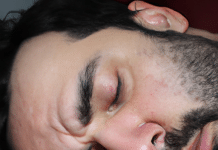Sleep patterns can undergo significant changes as we age, affecting the quality and duration of our sleep. From infancy to adulthood and into our senior years, the amount of sleep we need and the nature of our sleep can vary greatly. Understanding how age impacts our sleep patterns is crucial for maintaining optimal sleep health throughout our lives. In this article, we will explore the different ways in which age can influence our sleep, from the sleep needs of newborns to the sleep challenges faced by older adults. Whether you are an expecting parent, a young adult, or someone in their golden years, join us as we uncover the fascinating relationship between age and sleep patterns.
Review contents
Infants (0-12 months)
Sleep cycles
In the first year of life, infants undergo rapid changes in their sleep patterns. They transition from a predominantly REM (rapid eye movement) sleep cycle to a more adult-like sleep cycle with a mixture of REM and non-REM sleep. Initially, infants spend about 50% of their sleep time in REM sleep, which is important for brain development. As they grow, the proportion of non-REM sleep increases, and by the age of 12 months, they are similar to adults with roughly 25% of their sleep time spent in REM sleep.
Sleep duration
Newborns have an unpredictable sleep pattern, with sleep cycles lasting around 50-60 minutes. Over time, their sleep duration gradually increases, with most infants sleeping around 14-17 hours in a 24-hour period by 3-4 months of age. By the end of the first year, infants typically sleep for 11-12 hours at night, with two or three daytime naps.
Nighttime awakenings
Nighttime awakenings are common during infancy, primarily due to hunger, discomfort, or the need for parental intervention. Around 3-4 months of age, infants develop the ability to sleep for longer stretches at night, but intermittent awakenings may still occur. These awakenings are a normal part of their sleep pattern and gradually decrease as they grow older.
Sleep position
To ensure optimal safety and decrease the risk of sudden infant death syndrome (SIDS), the American Academy of Pediatrics recommends placing infants on their back to sleep. This position has been shown to reduce the incidence of SIDS. It is important to maintain a safe sleep environment, including using a firm mattress and avoiding soft bedding, pillows, or stuffed animals that could increase the risk of suffocation.
Toddlers (1-3 years)
Transition to single nap
Around the age of 1, most toddlers transition from two daytime naps to a single daytime nap. This transition can be challenging for both parents and toddlers, as they need to adjust to a new sleep schedule. It is important to provide a consistent sleep routine and create a conducive sleep environment to facilitate this transition.
Sleep duration and number of naps
Toddlers typically sleep for 11-14 hours in a 24-hour period, including their daytime nap. The duration of the nap varies among individuals, but it is generally around 1-3 hours. Some toddlers may resist napping, especially as they approach the age of 3, but regular naps are still important for their overall well-being and brain development.
Sleep schedule
Establishing a consistent sleep schedule helps toddlers develop healthy sleep habits. It is beneficial to have a fixed bedtime and wake-up time, which sets their internal body clock and promotes better quality sleep. Consistency in routine and sleep environment can also help reduce bedtime resistance and other sleep disturbances.
Sleep disturbances
Toddlerhood can be a time of increased sleep disturbances, including night waking, night terrors, and nightmares. These disturbances can be triggered by developmental milestones, changes in routine, or increased separation anxiety. Creating a calm and soothing bedtime routine, addressing any fears or anxieties, and providing comfort during nighttime awakenings can help manage these disturbances.
Preschoolers (3-5 years)
Decreased need for sleep
As children enter the preschool years, their overall sleep requirements gradually decrease. While individual variations exist, most preschoolers need about 10-13 hours of sleep in a 24-hour period. This can include a daytime nap, although some children may naturally outgrow their need for daytime napping by the age of 4 or 5.
Bedtime resistance
Preschoolers may start to exhibit bedtime resistance, which can manifest as delays, protests, or requests for repeated activities before going to bed. This behavior often stems from their desire for autonomy and a reluctance to end their day. By maintaining a consistent bedtime routine, setting limits, and providing reassurance, parents can help manage bedtime resistance.
Nighttime fears and nightmares
Preschoolers are known to have vivid imaginations, and this can contribute to an increase in nighttime fears and nightmares. Common fears include monsters, the dark, or imaginary creatures. Creating a safe sleep environment, using night lights, and providing comfort and reassurance can help alleviate these fears. It is important to validate their feelings and offer reassurance that they are safe.
Sleepwalking
Sleepwalking is more common in the preschool years and usually occurs during the first few hours of sleep. It is estimated that approximately 15% of children experience sleepwalking at some point during childhood. To ensure safety, parents should create a sleep environment free of hazards and gently guide the child back to bed if sleepwalking occurs.
Children (6-12 years)
Sleep hygiene
Children in this age group benefit from good sleep hygiene practices. This includes maintaining a consistent sleep schedule, creating a sleep-friendly environment (cool, quiet, and dark), and engaging in relaxing activities before bedtime. Establishing a bedtime routine that allows for winding down and limiting stimulating activities, such as screen time, can promote better sleep quality.
Sleep schedule consistency
Consistency in sleep schedules is vital for children’s overall well-being and academic performance. Regular bedtimes and wake-up times help regulate their internal body clock, making it easier to fall asleep and wake up at the desired times. It is important to maintain a consistent sleep schedule even on weekends and during holidays to prevent disruptions.
Sleep disorders (e.g., sleep apnea, restless leg syndrome)
Children can experience sleep disorders, such as sleep apnea or restless leg syndrome, which can affect their sleep quality and overall health. Sleep apnea, characterized by pauses in breathing during sleep, can lead to daytime sleepiness and behavior problems. Restless leg syndrome causes uncomfortable sensations in the legs, leading to difficulty falling asleep. If suspected, it is important to consult a healthcare professional for proper diagnosis and treatment.
Electronic device usage
The use of electronic devices, such as smartphones, tablets, and computers, has become increasingly prevalent among children. However, excessive screen time before bedtime can interfere with sleep quality due to the blue light emitted from these devices. It is recommended to establish screen-free time at least one hour before bed to promote better sleep.
Adolescents (13-18 years)
Delayed sleep phase syndrome
Adolescents generally experience a shift in their sleep-wake cycle, known as delayed sleep phase syndrome. This phenomenon occurs due to hormonal and biological changes during puberty, resulting in a preference for later bedtimes and wake-up times. It is important to create a sleep schedule that accommodates their natural sleep-wake patterns while considering the demands of school and extracurricular activities.
Sleep deprivation
Many adolescents face sleep deprivation due to various factors. Increased academic demands, social activities, part-time jobs, and the use of electronic devices can all contribute to inadequate sleep. Chronic sleep deprivation in adolescence has been linked to impaired cognitive function, mood disturbances, and increased risk of accidents. Encouraging healthy sleep habits, setting limits on screen time, and prioritizing sleep can help mitigate sleep deprivation.
Importance of sleep for academic performance
Adequate sleep is crucial for adolescents’ academic performance and overall well-being. Research has shown that sleep plays a vital role in consolidating information learned throughout the day, enhancing memory, and improving cognitive function. Promoting a balanced lifestyle that includes sufficient sleep can positively impact academic success and overall productivity.
Napping behavior
While daytime napping may lessen during adolescence, brief power naps can provide a temporary boost in alertness and performance. If napping becomes a regular practice, it is essential to limit nap duration to prevent interference with nighttime sleep. Naps should be shorter, ideally no longer than 20-30 minutes, and should not be taken too close to bedtime.
Young adults (19-25 years)
Shift in sleep-wake cycle
Young adulthood is a period of transition, marked by changes in lifestyle and responsibilities. Many young adults experience a shift in their sleep-wake cycle, known as a delayed phase preference. This preference for later bedtimes and wake-up times can be influenced by academic or work demands, social activities, and the availability of electronic devices. It is important to strike a balance between sleep schedules and daily commitments.
Influence of lifestyle factors
During young adulthood, lifestyle factors can significantly impact sleep patterns. Irregular work schedules, excessive workload, social engagements, and increased caffeine consumption can disrupt sleep quality and duration. Developing good sleep habits, such as maintaining a consistent sleep schedule, avoiding excessive caffeine intake, and creating a comfortable sleep environment, can help mitigate the effects of lifestyle factors on sleep.
Effects of alcohol and caffeine on sleep
Alcohol and caffeine consumption can have notable effects on sleep. While alcohol initially acts as a sedative, it can disrupt the second half of the sleep cycle, leading to fragmented and poor-quality sleep. Caffeine, a stimulant, can interfere with falling asleep and cause wakefulness if consumed close to bedtime. Moderation and timing are key when it comes to alcohol and caffeine intake to ensure optimal sleep.
Adults (26-64 years)
Changes in sleep architecture
As adults progress into middle adulthood, changes in sleep architecture become more apparent. There is a gradual reduction in the amount of deep sleep (slow-wave sleep) experienced and an increase in lighter stages of sleep. These changes can contribute to a perception of lighter and more disrupted sleep, as well as a decrease in sleep quality.
Sleep disorders (e.g., insomnia, sleep apnea)
Adults in this age range may experience sleep disorders such as insomnia, sleep apnea, or restless leg syndrome. Insomnia, characterized by difficulty initiating or maintaining sleep, can be caused by various factors including stress, anxiety, or medications. Sleep apnea, characterized by interruptions in breathing during sleep, can lead to daytime sleepiness and increased risk of cardiovascular problems. If sleep disorders are interfering with daily functioning, seeking professional evaluation and treatment is recommended.
Stress and sleep problems
Middle adulthood can be accompanied by increased responsibilities, work-related stress, and family obligations. These factors can contribute to sleep problems, including difficulties falling asleep, staying asleep, or achieving restorative sleep. Developing effective stress management techniques, establishing a relaxing bedtime routine, and seeking support when needed can help alleviate the impact of stress on sleep.
Nighttime awakenings
Nighttime awakenings become more common in adulthood, often associated with age-related changes in bladder function, hormonal fluctuations, or medical conditions. Managing disruptive factors, such as limiting fluid intake before bedtime, practicing good sleep hygiene, and addressing underlying medical conditions, can minimize the frequency and impact of nighttime awakenings.
Elderly adults (65+ years)
Changes in sleep quantity and quality
As individuals age, there is a natural decline in both sleep quantity and quality. Elderly adults often experience less total sleep time and increased wakefulness during the night. The amount of deep sleep further diminishes, leading to a tendency for lighter and more fragmented sleep. Despite these changes, it is important to prioritize sleep and ensure sufficient rest for overall well-being.
Insomnia prevalence
Insomnia, persistent difficulty falling asleep or staying asleep, is prevalent among older adults. Factors such as chronic pain, medical conditions, medications, or lifestyle changes can contribute to the development or exacerbation of insomnia. Addressing underlying causes, adopting good sleep hygiene practices, and seeking medical guidance can help manage insomnia in older adults.
Sleep disorders (e.g., sleep apnea, restless leg syndrome)
Elderly adults are at an increased risk of sleep disorders, including sleep apnea and restless leg syndrome. Sleep apnea, characterized by pauses in breathing during sleep, can lead to excessive daytime sleepiness and a higher risk of cardiovascular problems. Restless leg syndrome causes uncomfortable sensations in the legs, leading to an irresistible urge to move the legs. If sleep disorders are suspected, a healthcare professional should be consulted for proper diagnosis and treatment.
Medication effects on sleep
Many elderly adults take various medications, some of which can have an impact on sleep. Certain medications, such as diuretics, antidepressants, or those for managing chronic pain, can affect sleep patterns. It is important to discuss any concerns regarding medication and its potential effects on sleep with a healthcare provider, as they may be able to adjust dosages or recommend alternative medications.
Menopause and sleep
Hormonal changes and sleep disturbances
Menopause is a significant life transition for women that can be accompanied by hormonal changes and sleep disturbances. The fluctuation of estrogen and progesterone levels can lead to hot flashes, night sweats, and mood changes, all of which can disrupt sleep. Managing menopausal symptoms through hormone therapy, lifestyle modifications, and relaxation techniques can help improve sleep quality.
Hot flashes and night sweats
Hot flashes and night sweats are common menopausal symptoms that can significantly affect sleep. These sudden feelings of intense heat and excessive sweating often occur during the night, leading to disruptions in sleep. Creating a cool sleep environment, using moisture-wicking bedding, and wearing breathable sleepwear can alleviate the discomfort associated with hot flashes and night sweats.
Insomnia prevalence
Insomnia is a prevalent sleep disorder among menopausal women. The hormonal fluctuations during menopause can disrupt the ability to fall asleep or stay asleep. Managing stress, practicing relaxation techniques, and adopting good sleep hygiene habits can be beneficial for managing insomnia during this period of life.
Sleep quality and duration
Menopausal women often experience changes in sleep patterns, including decreased sleep quality and duration. Sleep disturbances, such as frequent awakenings or difficulty falling back asleep, can lead to feeling tired and fatigued during the daytime. Establishing a regular sleep routine, creating a comfortable sleep environment, and seeking professional advice if sleep problems persist can help improve sleep quality and overall well-being.
Effects of aging on sleep
Sleep disorders in older adults (e.g., sleep apnea, insomnia)
As individuals age, the risk of sleep disorders, such as sleep apnea or insomnia, increases. Sleep apnea, characterized by pauses in breathing during sleep, is more prevalent in older adults and is associated with an increased risk of cardiovascular problems. Insomnia, difficulty falling asleep or staying asleep, can also become more common with age. Seeking proper diagnosis and treatment for sleep disorders is important for improving sleep quality and overall health in older adults.
Changes in sleep architecture
Aging is accompanied by changes in sleep architecture, including a decrease in deep sleep and an increase in lighter stages of sleep. This can contribute to feeling less rested and more easily awakened during the night. Despite these changes, maintaining good sleep habits, practicing relaxation techniques, and creating a sleep-friendly environment can help optimize sleep quality.
Circadian rhythm changes
The aging process can lead to changes in the circadian rhythm, the internal body clock that regulates sleep-wake cycles. Older adults tend to go to bed earlier in the evening and wake up earlier in the morning. These changes can sometimes pose challenges if they do not align with societal obligations or preferences. Adapting sleep schedules to fit individual circadian rhythms can help ensure adequate sleep.
Impact of medical conditions on sleep
The presence of chronic medical conditions, such as arthritis, chronic pain, or urinary problems, can affect sleep in older adults. Pain, discomfort, or the need for frequent trips to the bathroom can disrupt sleep continuity and quality. Managing underlying medical conditions through appropriate medical treatment, lifestyle modifications, and consulting with healthcare professionals can help alleviate the impact of these conditions on sleep.



























